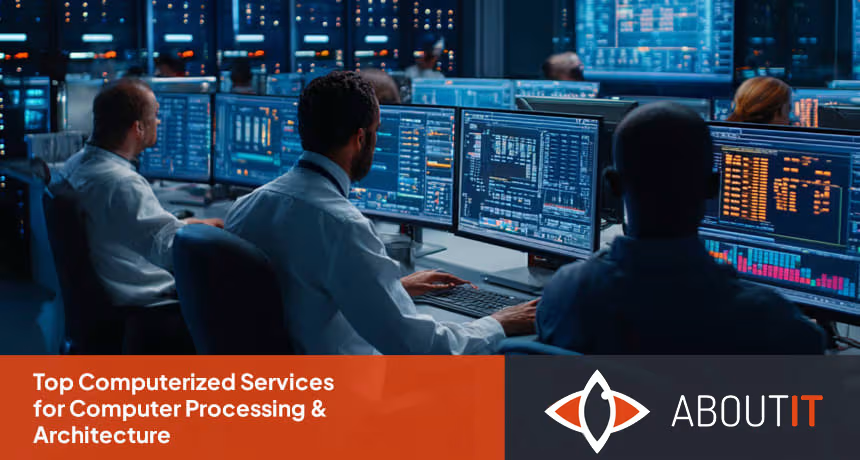Imagine stepping into the world of IT, filled with lots of pieces and parts. It's easy to feel lost, right? But don't worry; you're not alone.
In a world that's always changing, getting to know the different IT infrastructure components is like having a special key. You might be asking, "What are the main parts of IT?" or "How can I make my IT better?" This blog will answer those questions.
We'll talk about things like servers, routers, and cloud services in a way that's easy to understand. You'll learn how to find the best solutions, make things work better, and make sure everything is secure. It's all within your reach.

What is IT infrastructure & why is it important to improve your IT?
Picture this: you enter a large, bustling city. You see all the roads, buildings, and bridges. In the world of technology, that's IT infrastructure, also called technology infrastructure.
IT infrastructure refers to the backbone of your operating system, holding everything together within the infrastructure. The better and stronger it is, the smoother things run. It includes computer hardware, software, networks, and more, ensuring your emails reach their destination, your data is saved, and your messages are sent.
It's crucial, right? Now, you can probably see why it's important to know about and improve IT infrastructure.
In the growing digital age, a sturdy, efficient, and secure IT system is a must-have. It's not just about avoiding glitches and delays but about soaring to new heights, enhancing performance, and ensuring robust security.

Traditional vs. cloud infrastructure: How are they different in infrastructure management?
Knowing why IT infrastructure is important or how it works is crucial to succeeding in your IT enhancement. Whether traditional or cloud infrastructure, each plays a significant role in ensuring seamless operations and communication in the global digital landscape. But how are they different?
Cloud infrastructure
In the modern digital age, cloud infrastructure is like a futuristic cityscape. It is the architecture or type of infrastructure allowing businesses to store data, run applications, and manage operations over internet connectivity, bypassing the need for physical, on-site systems.
Traditional infrastructure
Traditional infrastructure, on the other hand, is like the solid foundation of an age-old building. It encompasses the physical hardware and systems essential for IT operations, providing a stable and secure environment.

What are the types of IT infrastructure components?
In the vast world of IT, various components come together to ensure everything runs as it should. Understand these pieces, and you�ll hold the key to managing and improving your IT system. Let's delve deeper into some major IT infrastructure components to clear the haze surrounding them.
Hardware: The physical essence
One of the major components of IT infrastructure includes hardware. This is the physical aspect of IT, including servers, computers, and other equipment. Each piece plays a critical role in ensuring operations run seamlessly and efficiently. Just like the sturdy structures in a city ensure smooth transit and shelter, the hardware provides the essential foundation for your IT operations.
Software: The invisible force
Software is the invisible force driving your IT infrastructure. It's the programs and applications that ensure tasks are executed efficiently. Your software IT infrastructure components should be consistently updated and optimized to adapt to the ever-evolving digital world.
Network: The connecting links
Networks, including routers and other network devices, bind various IT components, ensuring they communicate and function together in harmony. A robust and secure network ensures the seamless flow and exchange of data.
Data center: The heart of operations
The data center is the powerhouse IT infrastructure component - storing, processing, and distributing large amounts of data. It's the core that keeps the digital pulse beating, ensuring your IT system is alive, dynamic, and responsive to your needs.
Remote connectivity: The extended reach
In today's world, ensuring a connection beyond physical boundaries is imperative. Remote connectivity allows access to resources and information from anywhere, guaranteeing your IT infrastructure is not confined but expansive, adaptable, and universally accessible.

Why is the network the most important IT infrastructure component?
Imagine walking into a big city for the first time. It's filled with buildings (hardware), people (software), and roads (network) that connect everything. But what's the most important IT infrastructure component? It's the network - the roads. They hold everything together.
In the world of IT infrastructure, it�s the same. Think of it like this: the network is like the streets of the city, linking everything and everyone. It makes sure that messages (data) can move smoothly from one place to another. It connects all the parts of IT - hardware, software, and more - allowing them to work together as a team.
Without good roads (network), even the nicest buildings (hardware) and people (software) can't work together properly. So, when you think about IT infrastructure, remember to focus on the network. Make sure it's strong and reliable, helping every part of the IT city to be its best.

How do you improve your connectivity & data center through IT infrastructure?
Improving IT infrastructure is paramount for ensuring the efficiency, reliability, and security of your technological environment. Follow this step-by-step guide to enhance your IT infrastructure systematically:
Step 1: Conduct an IT infrastructure assessment
Begin by evaluating your current IT infrastructure. Analyze hardware, software, network, and security systems to identify existing bottlenecks, vulnerabilities, and inefficiencies. Understand your organization's unique requirements and align your IT strategy to meet these needs.
Step 2: Prioritize security
Enhance the security of your IT infrastructure. Update your firewall, antivirus software, and other security tools. Conduct regular security audits and vulnerability assessments to safeguard your systems from potential threats. Educate employees about security best practices.
Step 3: Upgrade hardware and software
Obsolete hardware and software can hamper performance and pose security risks. Upgrade your servers, computers, and other hardware components. Ensure that your software applications are up to date, and consider migrating to cloud-based solutions for scalability and flexibility.
Step 4: Optimize network performance
Ensure your network infrastructure supports the current and future workload. Opt for high-speed, reliable, and secure connectivity solutions. Consider implementing a Virtual Private Network (VPN) for secure remote access. Regularly monitor network performance and resolve issues promptly.
Step 5: Implement automation and virtualization
Leverage automation to streamline operations and reduce manual effort. Utilize virtualization technologies to optimize resource utilization, enhancing efficiency and reducing costs.
Step 6: Focus on data management
Prioritize efficient data storage, backup, and recovery solutions. Implement robust data management practices and consider solutions like on-site or cloud-based data storage and backup services for enhanced data security and availability.
Step 7: Train your team
Ensure your team is knowledgeable about the latest technologies, security practices, and IT management strategies. Provide regular training and access to resources for continuous learning and improvement.
Step 8: Monitor, analyze, and iterate
Continuously monitor your IT infrastructure�s performance. Use analytics tools to glean insights into infrastructure performance and user behavior. Regularly seek feedback from users and IT staff to make informed, iterative improvements to your IT infrastructure.
Step 9: Seek professional expertise
Consider engaging with IT consultants or managed service providers for expert insights and assistance in optimizing your IT infrastructure.
Step 10: Plan for the future
Keep abreast of emerging technologies and trends. Future-proof your IT infrastructure by planning and investing in technologies that will support your organization's growth and evolving needs.

Still confused with all the components of IT infrastructure? Choose About IT!
Stepping into the world of IT can often feel like diving into an endless ocean. As you sail through this journey, understanding the importance of a robust IT infrastructure stands paramount.
But hey, there's no need to feel lost in the complicated maze of IT infrastructure. You have a reliable partner ready to navigate you through.
About IT is here to turn the tide in your favor. We bring forth an array of comprehensive IT infrastructure solutions tailor-made to meet your needs. From remote work solutions to advanced cybersecurity, we ensure your IT setup is not just up-to-date but ahead of the curve.
Remote work solutions? Checked! Enhanced security? Absolutely! Disaster recovery? You bet! Our benefits are endless and exclusively tailored for you, ensuring your IT environment is resilient, efficient, and agile.
With our focus on Microsoft 365 and Azure cloud technologies, our expertise lies in optimizing IT for undeniable business growth, backed by 24/7 support and advanced cybersecurity measures.
Do not let the technical jargon and complexities pull you down. Reach out to us at +32 473 67 62 51 or email us at info@aboutit.be for solutions designed for simplicity, efficiency, and growth.
Frequently asked questions
What is a data center in terms of IT infrastructure?
A data center is a physical space where an organization's computing resources, such as servers, storage devices, and network components, are housed. It�s a crucial element of information technology infrastructure, managing and organizing the vast amount of data storage and processing necessary for business operations.
Can you provide some infrastructure examples?
Infrastructure examples include both on-premises hardware infrastructure and cloud computing models. On-premises examples are traditional IT infrastructure where physical components work together within an organization's location. Cloud IT infrastructure, like IaaS, is another example where infrastructure services are hosted by a third-party service provider on a public cloud, ensuring flexibility and scalability for business needs.
How does a server differ from other hardware components?
A server is a specific hardware component designed to manage network resources and provide services to other computers in the network. It hosts web servers, customer relationship management systems, and content management systems, ensuring seamless workload management and enhanced productivity.
Why is cloud IT infrastructure considered advanced?
Cloud IT infrastructure is deemed advanced because it transcends the limitations of physical resources. It enables virtualization, where software applications emulate hardware, providing scalable resources according to business operations� demands without the need for physical space or additional hardware and software components.
How does infrastructure as a service enhance business operations?
Infrastructure as a service (IaaS) significantly enhances business operations by offering scalable, flexible, and cost-effective solutions. It eliminates the need for on-premises infrastructure, reducing capital expenses and offering easy access to computing resources, enhancing overall productivity and efficiency.


.jpeg)

.avif)










